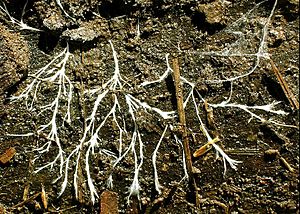Saprotrophic nutrition facts for kids
Saprotrophic nutrition is how some living things get their food by breaking down dead or decaying organic matter. Think of it like nature's recycling system! Organisms that do this are called saprotrophs.
The most common saprotrophs are fungi (like mushrooms and molds) and many types of bacteria found in the soil. These tiny helpers are essential for keeping our planet clean by returning nutrients from dead plants and animals back into the environment.
You might hear other words that sound similar, like "saprophytes." This term was once used for plants thought to feed this way. However, scientists now believe that plants previously called saprophytes actually get their food by connecting with microscopic fungi or other plants, rather than directly eating dead matter themselves.
Contents
What is Saprotrophic Nutrition?
Saprotrophic nutrition is a special way organisms eat. Instead of swallowing food, saprotrophs release special chemicals, called enzymes, outside their bodies. These enzymes break down complex dead material into simpler parts. Then, the saprotroph absorbs these simpler nutrients through its cell walls.
This process is a type of extracellular digestion, meaning "digestion outside the cell." It's a bit like if you sprayed a special liquid on your food to break it down before you could sip it up!
How Saprotrophs Get Their Food
When a saprotroph, like a fungus, finds dead organic matter (like a fallen leaf or a dead log), it starts its feeding process. The main body of a fungus is a network of tiny threads called hyphae, which together form a mycelium. These hyphae grow into the dead material.
Breaking Down Food
The hyphae release enzymes that act like tiny scissors, cutting up the large food molecules:
- Proteins, which are like building blocks, are broken down into smaller pieces called amino acids by enzymes called proteases.
- Lipids (fats) are broken down into fatty acids and glycerol by enzymes called lipases.
- Starch, a common energy storage in plants, is broken down into simpler sugars by enzymes called amylases.
- Cellulose, which makes up the strong walls of plant cells, is also broken down into glucose (a simple sugar).
Absorbing Nutrients
Once these large molecules are broken into smaller, simpler parts, the saprotroph can absorb them. These small nutrients pass through the cell walls of the hyphae and are then transported throughout the entire mycelium. This allows the fungus to grow, repair itself, and produce new parts.
What Saprotrophs Need to Grow
For saprotrophs to do their best work and grow well, they need the right conditions and plenty of nutrients.
The Right Environment
Here are the key things saprotrophs need in their environment:
- Water: Fungi are mostly water, and they need a lot of it from their surroundings. This helps them absorb nutrients and replaces water lost through evaporation.
- Oxygen: Most saprotrophs need oxygen to live and grow. This is why you often see fungi growing on the surface of soil or wood, rather than deep inside where there's less air.
- pH Level: They prefer conditions that are neutral or slightly acidic, usually around a pH of 7 or a little lower.
- Temperature: Most saprotrophs grow best in cool to medium temperatures, typically between 1 and 35 °C (34 and 95 °F). Their ideal growing temperature is usually around 25 °C (77 °F).
Essential Nutrients
The main nutrients saprotrophs need are:
- Carbon: This is a huge part of all living things. Dead organic matter is full of carbon in forms like sugars (disaccharides, polysaccharides like maltose and starch, and monosaccharides like glucose).
- Proteins: These are also found in dead organisms and provide essential building blocks.
- Vitamins and Ions: These are needed in smaller amounts but are still important for the saprotroph's health and functions.
See also
 In Spanish: Nutrición saprotrófica para niños
In Spanish: Nutrición saprotrófica para niños
- Decomposers
- Detritivore
- Holozoic nutrition
- Mycorrhizal fungi and soil carbon storage
- Parasitic nutrition
- Saprotrophic bacteria
- Wood-decay fungus


